The best Gwent decks for beginners
Our guide to Gwent's basics and factions, and the best decks and card combos that will carry you to the win.
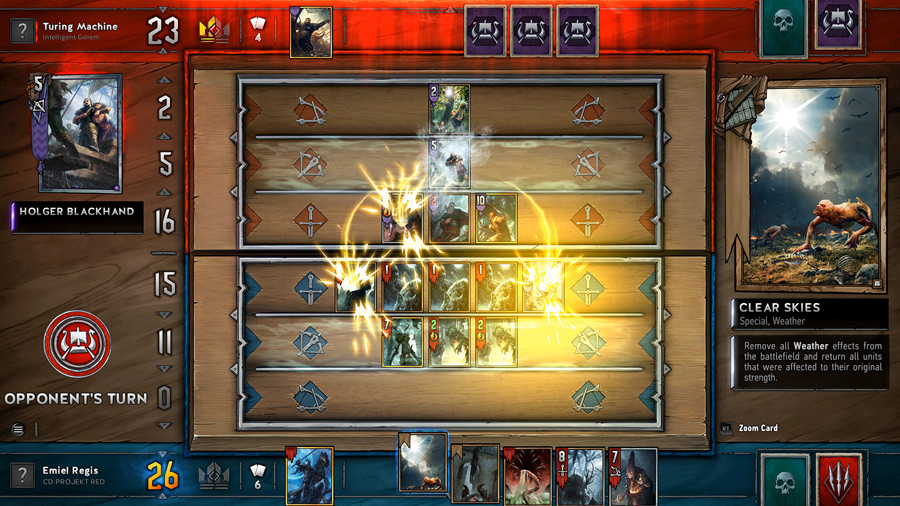
You can chop the entire Wild Hunt into tiny, oozing pieces with just a few flicks of your sword. Your bar-brawling skills are unmatched. You even managed to perform coitus on an ornamental unicorn once without making too much mess. But when it comes to the standalone version of The Witcher 3’s card game, you’re getting nowhere. What gives? Don’t worry, we’ve deployed ourselves within Gwent like a Nilfgaardian Emissary (lesson one: that's a spy card!) for the current open beta, and we’re here to take the sting out of the beginner phase with some useful tips and killer decks.
Gwent differs from most CCGs in a few key areas, and although it can become quite complex, the basic rules are extraordinarily simple. The very first step along the path to excellence, then, is understanding the rules and characteristics of Gwent, and learning how to turn them to your advantage. Here's what you need to know to take advantage of our recommended decks.
Basic rules
It’s a 1v1, best-of-three game played with a deck of 25-40 cards for each player. Your aim is to finish the round so that your cards on the board add up to a higher number than your opponent’s. You take turns playing cards until both players pass a round (in which case the current score is final) or one player has no more cards to play.
That’s it. Boiled down to its fundamentals, Gwent is even simpler than Hearthstone or Magic: the Gathering. It’s all about generating as high a number as possible, with as few cards as possible. Complexity lurks under the surface thanks to the abilities and interactions of cards, and the fact you’re playing a match over three rounds with a diminishing deck. Cards are the single depletable resource here. No mana, no power, just cards.
It sounds redundant to say given that we’re talking about a CCG, but that means learning the strengths and weaknesses of every card in your deck is vital. There’s only one way to do that: play a lot of Gwent.
The scarcity of cards means card advantage is massive. If a match is tied one round apiece and you go into the final round with even one more card in your hand than your opponent, the odds are stacked enormously in your favour. Throughout a match you should always keep an eye on the number of cards each of you have left. If your opponent establishes an advantage in round one that will take several cards to overcome, it may be best to save your cards, cut your losses, and pass to lose the round. Again, that's true of most CCGs, but vital in Gwent.
Gwent is still in beta and has a helpful tutorial, but doesn’t do the best job of bringing absolute beginners up to speed with all of its mechanics and terminology. Check out the glossary on page two to get a grip of Gwent’s many mechanics. Don't worry about memorizing it right away—use it as a helpful resource when you're deckbuilding and figuring out which cards work well with each other.
The biggest gaming news, reviews and hardware deals
Keep up to date with the most important stories and the best deals, as picked by the PC Gamer team.
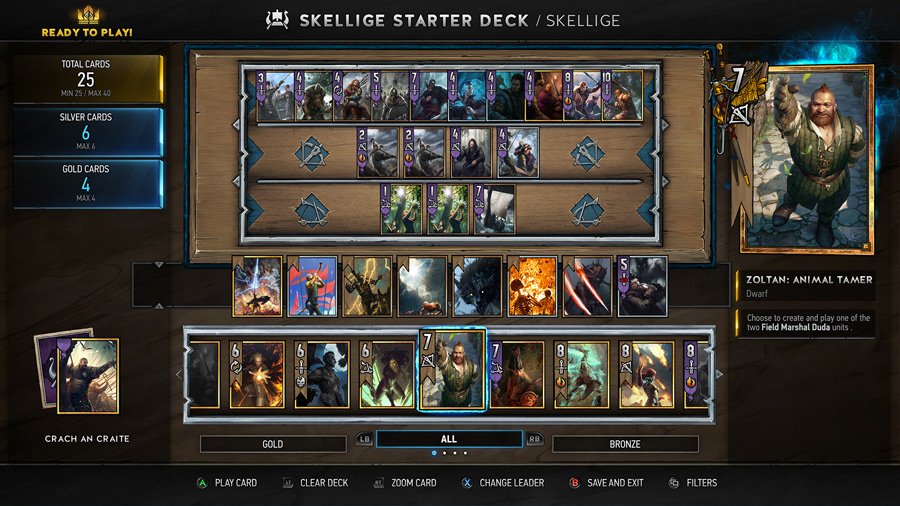
Card types
Decks contain 25-40 cards, made up of units of varying rarities and colours. Gold cards are generally the most powerful in the game, and the rarest to find in kegs (Gwent's version of card packs). Below them are silver and bronze cards. When building a deck you can have up to three copies of any bronze card, but only six silvers and four golds total. Most competitive decks have 25 cards in them—maxing out on golds and silvers.
Traditional CCG wisdom would have it that you should build a deck around the golds, but that doesn’t hold entirely true in Gwent. While an individual gold card can provide a swing moment in a round, the composition of silver and bronze cards in your deck is equally important—some would argue even more important. It all comes down to deck composition, as you’ll see in the decks below.
In addition to their colour and power, cards also have a positional attribute. Agile cards can be played in any row, while melee cards can only be deployed in the front row. Ranged cards live in the middle row, and siege are deployed on the back row.
Positioning matters because a) you can often buff cards on the same row and b) weather effects impact all cards on the same row. If you played some Gwent in The Witcher 3 and remember how weather worked there, note that it’s different in the standalone. All three rows are now targets for any of the weather-triggering cards, and they each manifest different effects now. Monsters can use frost to create chain reaction buffs when it damages an opposing unit, for example.
Cards also come in white, blue, purple, and gold rarity values, with white the most common and gold the rarest. This really only impacts how many scraps they produce when you mill them, so it’s only something to worry about from a collector’s standpoint, rather than a tactician’s.
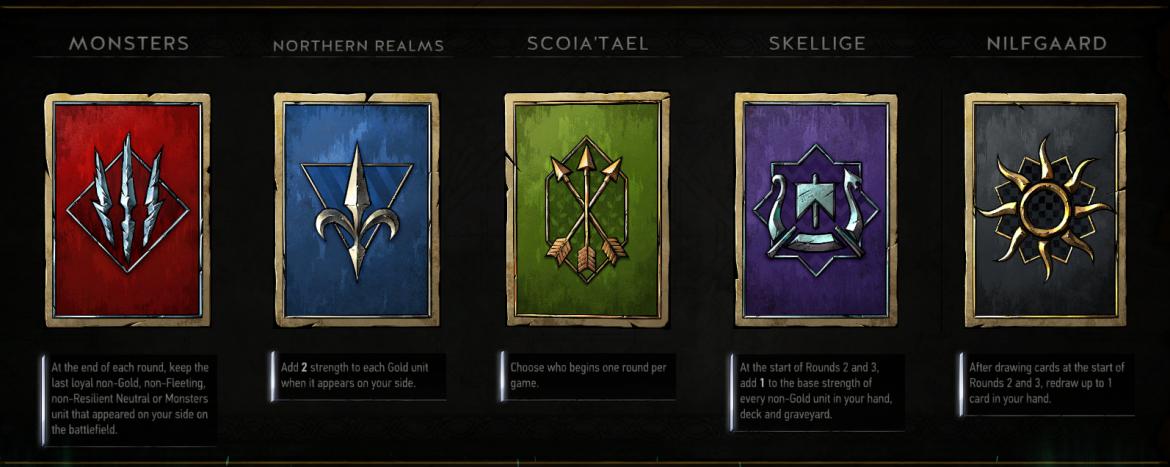
Factions and decks
There are five factions in Gwent, each with their own leaders, archetypes, and unique cards. And before you ask: no, there isn’t a ‘best’ faction. Not even at an absolute beginner level. They’re all equally easy to understand, and no single faction requires more skill to play effectively than the others.
Now let’s dive deeper into their characteristics and a recommended deck composition for each faction.
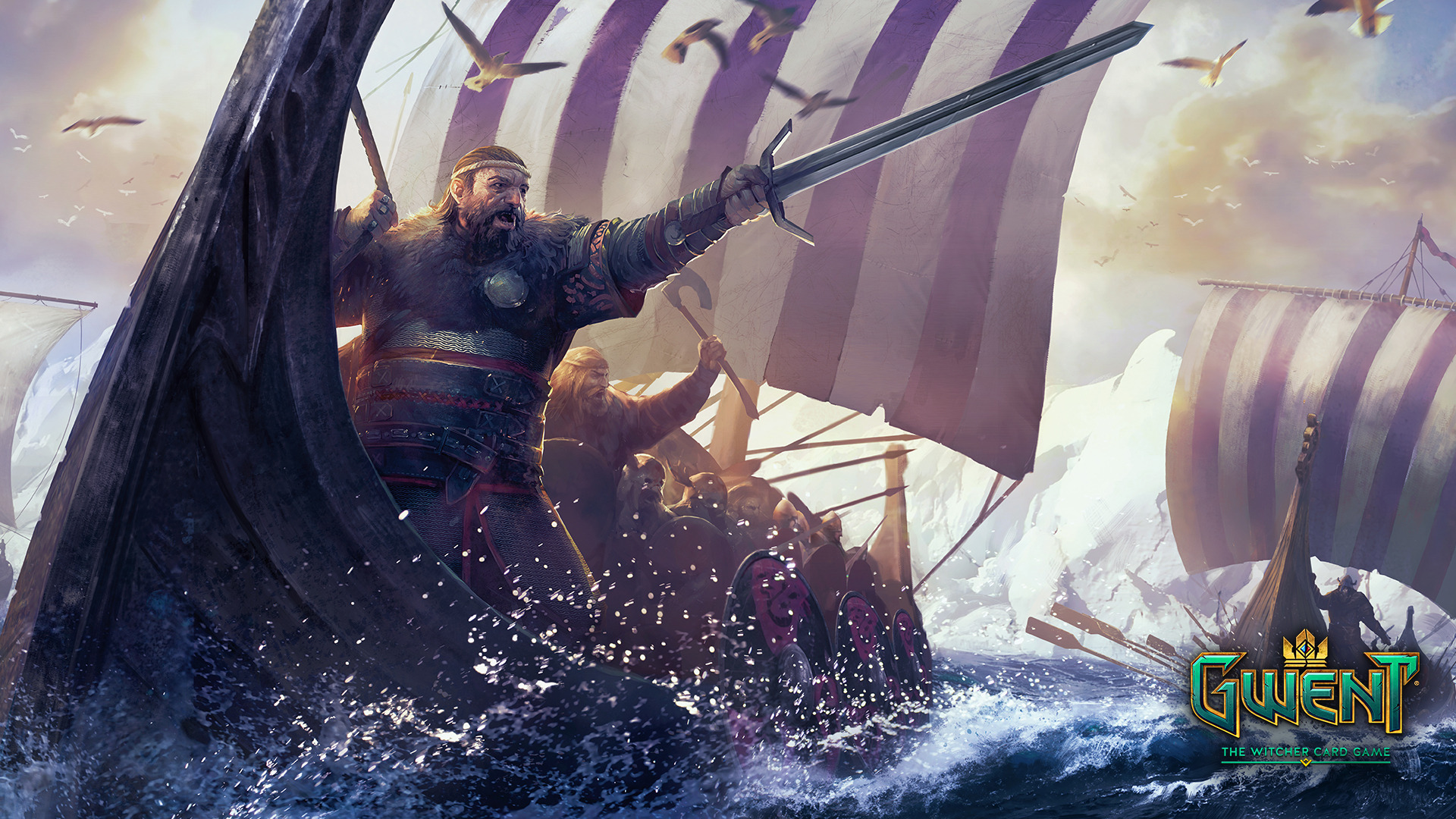
Skellige
Skellige are a hardy bunch, with a playstyle built around harming (and then buffing) many of their units. Their leader cards are:
Harald the Cripple - Deploy: Damage a Unit by 5. If this Destroys it, repeat this ability with Damage Power reduced by 1.
Crach en Craite - Deploy: Play the Highest Loyal Bronze or Silver Unit in your Deck, Strengthen it by 3 and Damage it by 1.
King Bran - Deploy: Discard up to 3 cards from your Deck and Strengthen all Units among them by 1. Then shuffle your deck.
You begin with Crach en Craite in your starter’s deck. Like several other Skellige units, he uses a self-wounding ability when deployed, and that takes a little getting used to. However, several others in the Skellige ranks can resurrect units from the graveyard or boost damaged units. Clain Tuirsearch Skirmishers, for example, begin on 6 power and receive a +3 boost whenever they enter the graveyard. This trait means you can play an effective long game by baiting the other player into sending your units to the graveyard early in round one, then resurrect them and strengthen your hand later in the game.
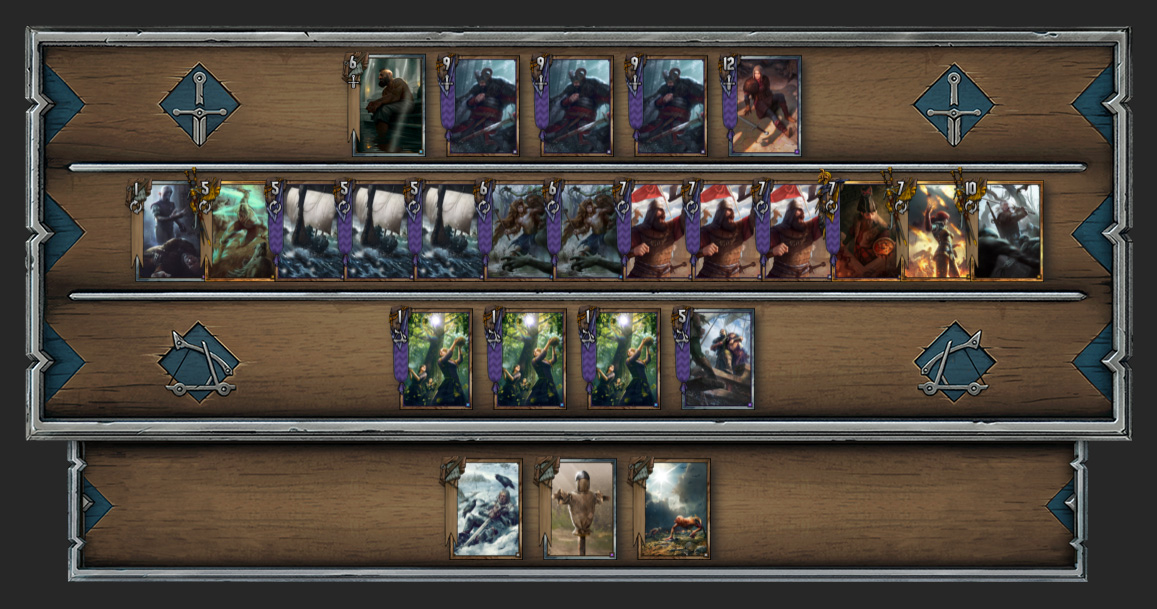
Best Skellige deck: Zinos’ ‘Budget Skellige Warcrier’ midrange deck
We love this deck for two reasons. Firstly, it capitalises on Skellige’s strengths beautifully (losing round one to strengthen your hand in two and three) and secondly, it’s built primarily with cards you’ll begin the game with in your starter deck.
Since you want to lose round one but do so with minimal card expenditure, you begin by playing Geralt and Ciri to lay a total of 15 power in two cards. That puts the opponent in a tricky situation: play a lot of cards to make up the shortfall, or lose the round. Ciri gets reshuffled back into your hand in the next round if you lose anyway, so it’s a great way to lay the foundations of your tactic.
In rounds two and three you’re using your key combo (see below) to generate huge chain boosts. It’s entirely possible to get 70-80 power down on the board in a single round, which will be very hard for any opponent to keep pace with, but especially difficult for one who’s a card down after outspending you in round one.
Key combos: it’s about deploying Warriors, Warcriers, and Light Longships, of which you have three each. Warcriers boost your Warriors, and Light Longships wound them again, so by cycling the three you can work up a massive boost. If your opponent allows it, play at least two Warriors before dropping a Warcrier for a bigger boost.
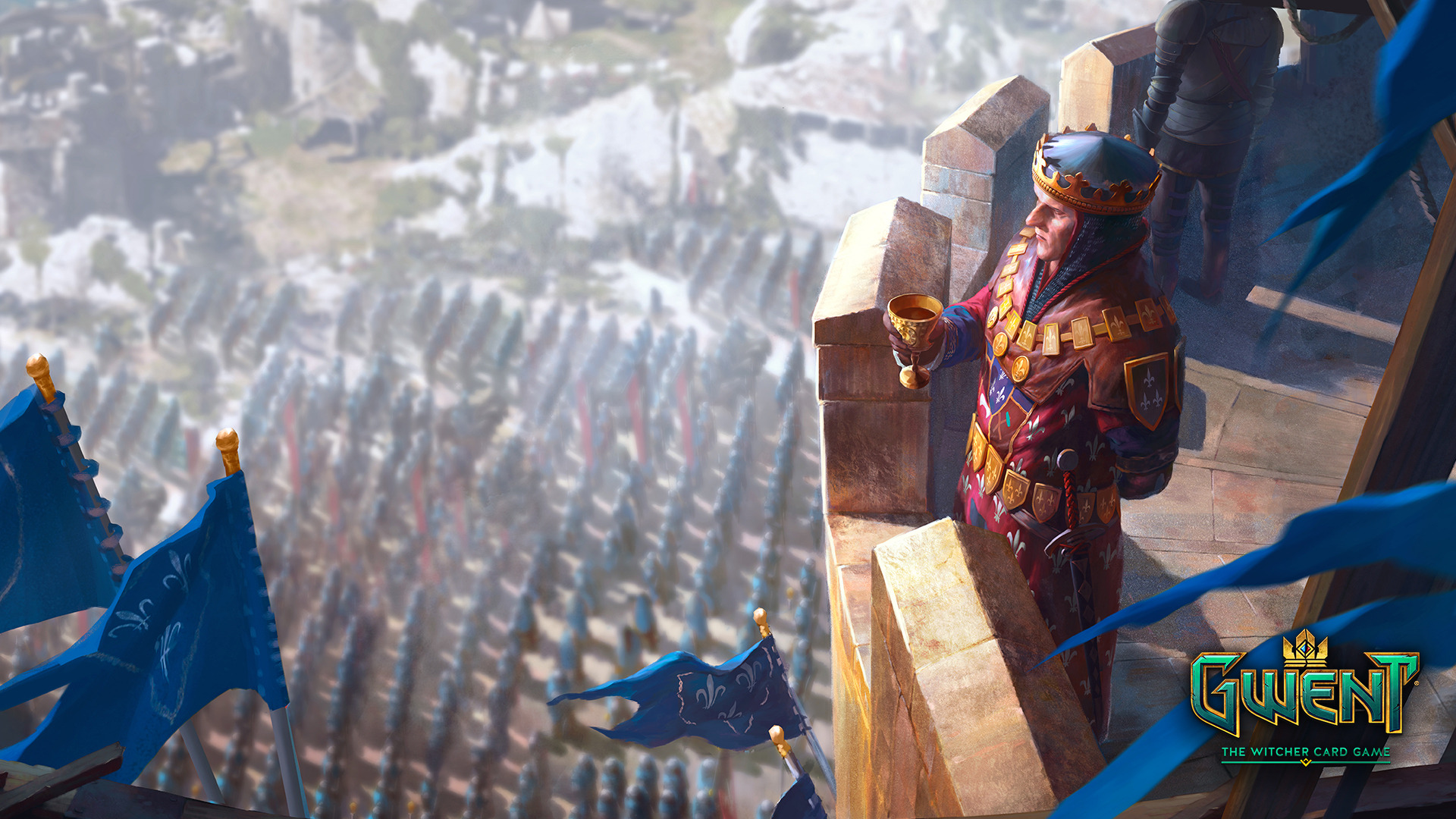
Northern Realms
Foltest, Radovid, and Henselt lead the Northern Realms. What lovely chaps they all are, too. Here’s what each leader can do for you:
Foltest - Deploy: Boost all Loyal Bronze and Silver Units in your Hand and Deck by 1.
Radovid - Deploy: Toggle 2 Units' Lock. If Enemies, Damage them by 4 as well.
Henselt - Deploy: Choose a Bronze Ally. Play all copies of it from your Deck.
If Skellige are all about bloodletting and resurrection, Northern Realms are, to use the community parlance, unit-spammers. Several Northern Realm units will deal power or armor boosts to adjacent cards, for example, and King Henselt’s special ability lets you play all copies of a bronze unit when you trigger his special ability. It’s like building an army, really. Clever.
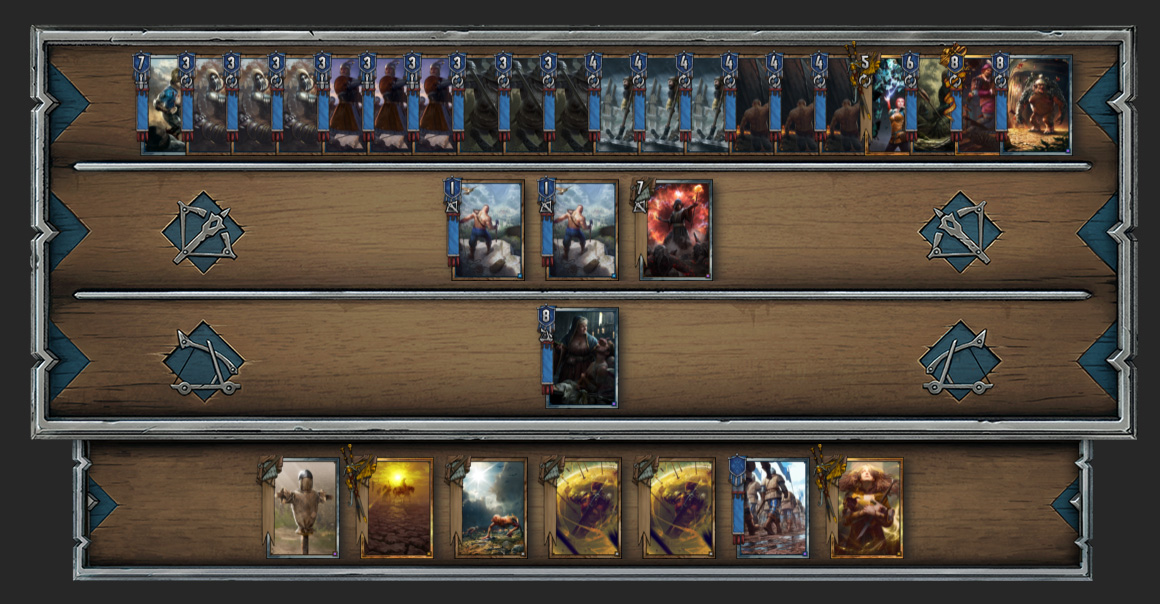
Best Northern Realms deck: NevadaJack’s ‘Reaver Commando Re-Rush’
Like any good NR deck, this one can generate a frankly flabberghasting number of cards from just a few plays. Ideally you begin by playing as many of your Kaedweni Sergeants as you have in your hand. They’ll summon a Blue Stripes Commando to the board and both will be boosted. When you’ve got all three Blue Stripes Commandos out, you’ll create another that goes at the bottom of your deck. If you manage to get all these cards out onto the board and have Triss: Butterfly Spell in your hand, you can create an enormous overall boost.
In later rounds it’s about completing a trio using your Reaver Hunters, which will summon Ves for an additional 7 power. Trollolo’s there to stand in as a trio member if needed. You’re vulnerable to weather effects with this deck since you’ll have so many units on the same row, so there’s a First Light included to clear any adverse weather.
Key combos: Kaedweni Sergeant and Blue Stripes Commando. An efficient, powerful duo which creates many units at a low card cost.
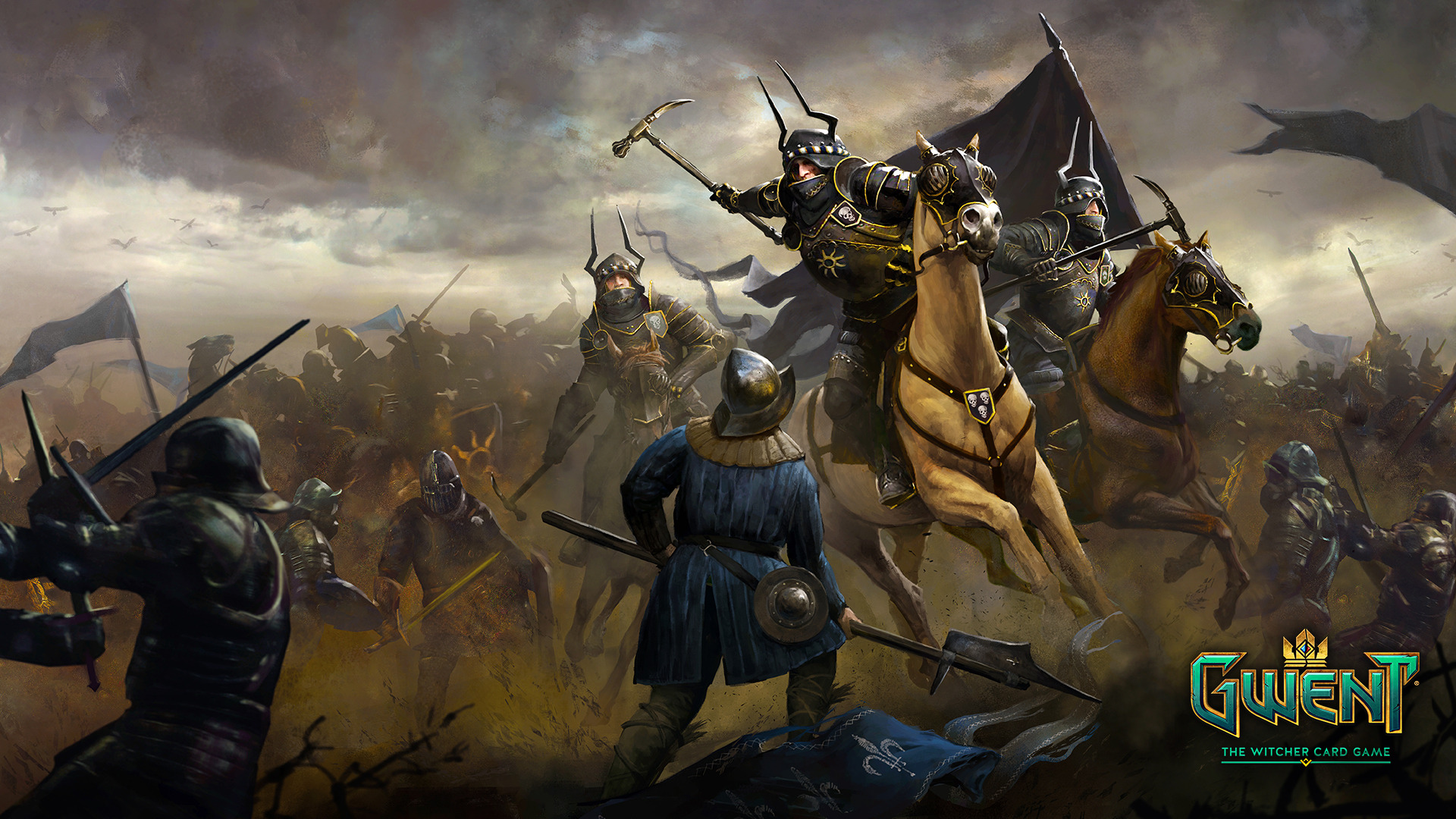
Nilfgaard
The sneaky Nilfgaardians are led by Morvan Voorhis, Eymhr var Emreis, and John Calveit. Here’s how the leaders line up:
John Calveit - Deploy: Look at the top 3 Bronze or Silver cards in your Deck. Play 1. The others remain on top.
Eymhr var Emreis - Deploy: Return an Ally to your Hand, then play a card from your Hand (can be Gold).
Morvan Voorhis - Deploy: Reveal up to 3 cards from either player's Hand (can be Golds).
They’re all about getting units on the opponent’s side of the deck and controlling the game from there. That might come via an Emissary who lets the player draw two bronze cards from the deck and play one. Or it might mean hurling a rotting cow carcass next to enemy units with a Rot Tosser and forcing the opponent to deal with it before it wipes out the entire row. The Emissary and Vicovaro Novice stack well together too, so it’s possible to build an effective spy deck with the Nilfgaard.
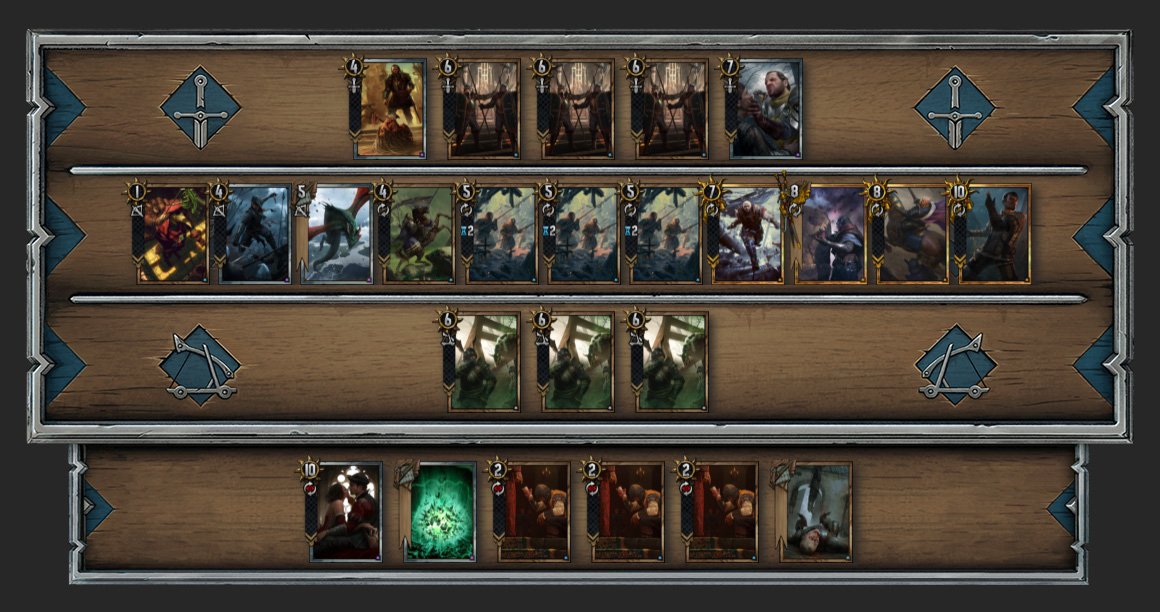
Best Nilfgaard deck: Copinhobr’s ‘My Time to Shine’
This deck works so well because it grants you so many options to maintain the initiative. The ever-multiplying Alba Pikeman will force an opponent to spend their cards nullifying their increasing threat, and make for a great first round deploy to establish control. From there you have a very situational deck designed to give you a counter to enemy plays from any faction. Sweery and the Rot Tossers (we’ve copyrighted this as a band name) will help nip Northern Realm or Monster card-multiplying plays in the bud, and having three of the latter in your siege row will force the other player to have to deal with cow carcasses rather than bolstering their own force. To cap it off, The Impera Brigade get a +2 boost every time an Emissary is played.
Key combos: Impera Brigade and Emissary. Play an Emissary first and then deploy the Brigade to get the boost. Even if you don’t have one in your hand when you play the Emissary, there’s a chance it’ll be one of the two cards you’re offered from the deck afterwards.
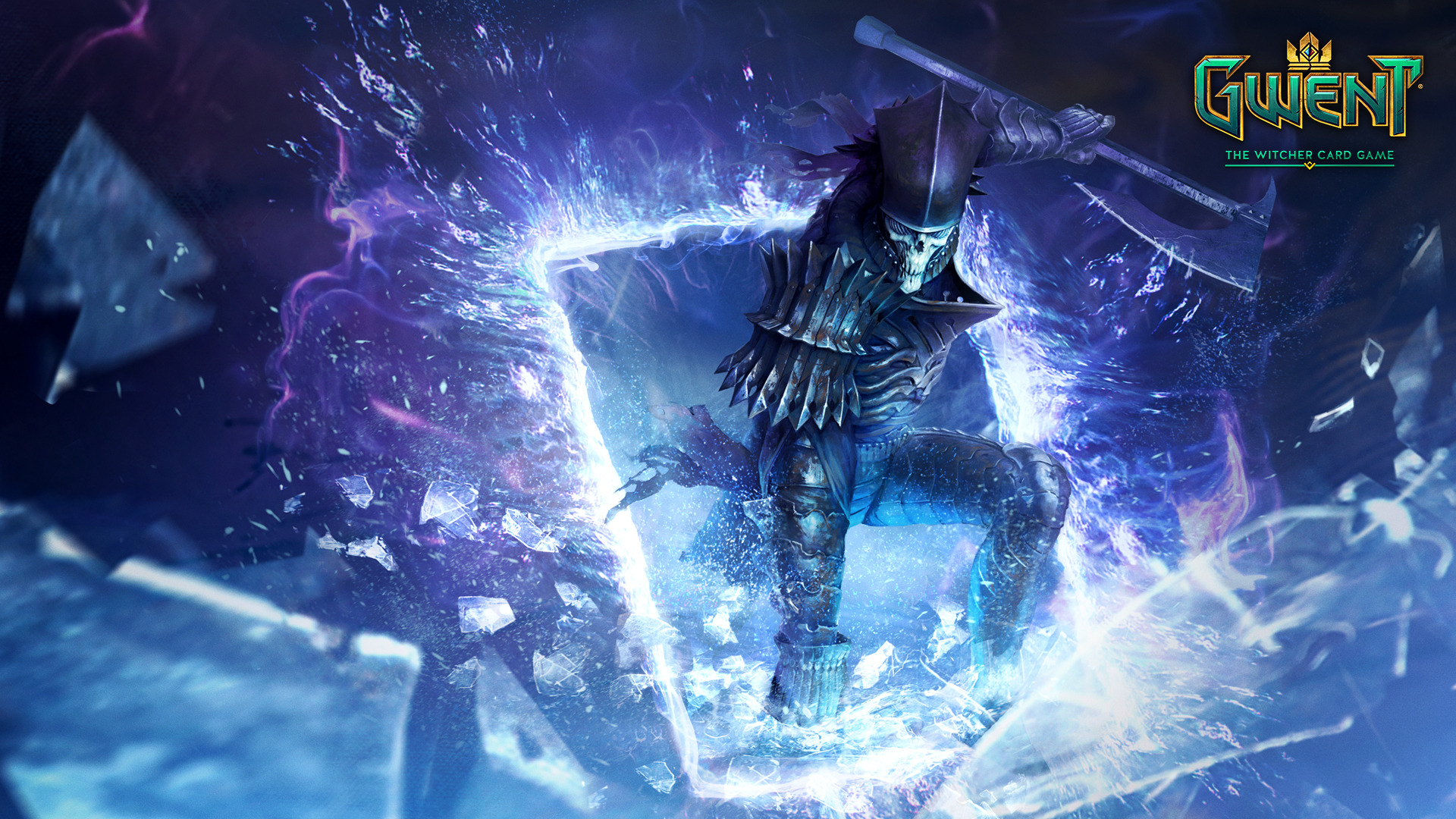
Monsters
What’s that coming over the hill, is it a—oh, our mistake, it’s only a deck of cards. The monsters are led by Eredin, Unseen Elder, and Dagon, who grant you the following:
Eredin - Deploy: Spawn a Bronze Wild Hunt Unit.
Unseen Elder - Deploy: Consume 3 Allies, but Strengthen instead of Boosting.
Dagon - Deploy: Spawn Biting Frost, Impenetrable Fog or Torrential Rain.
Monsters are really into controlling the weather. This buffs their units while also making life difficult on the other side of the board and increasing certain types of attack. Monsters also receive considerable buffs for consuming opposing units, so you can tailor your deck to either of these archetypes.
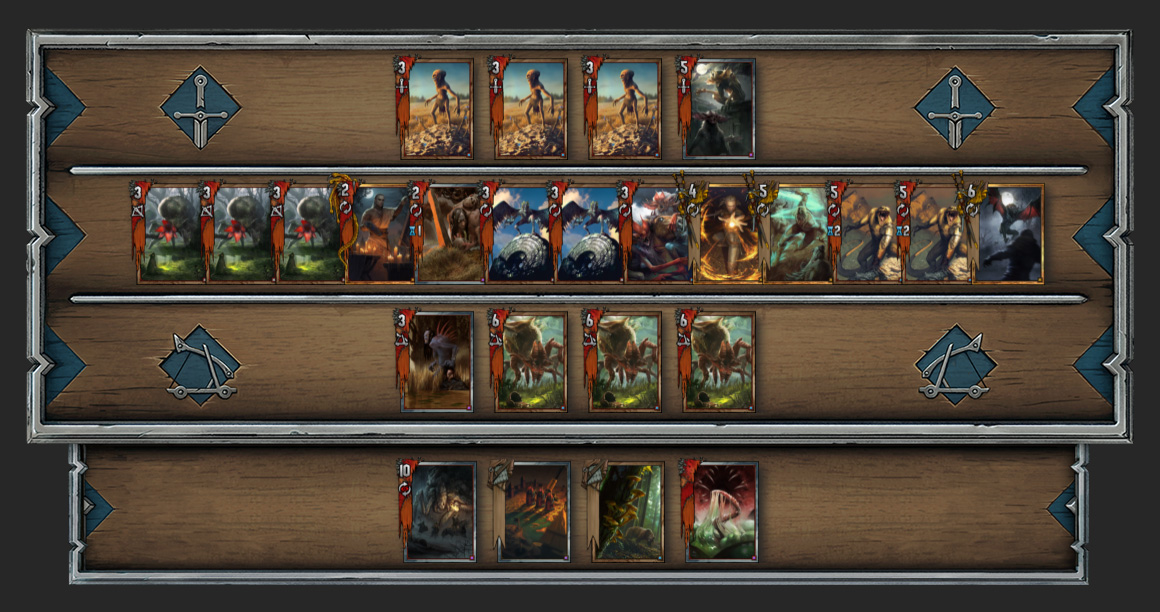
Best Monsters deck: Fedelty’s ‘Post-Patch Consume’
Built to capitalise on the most recent balance changes at the time of writing, here’s a deck full of consume cards that can massively overpower opponent’s deck when deployed correctly. The two Vran Warriors consume a unit to their right upon deployment and every two turns after that, so they’ll become formidable in just a few turns unless they’re dealt with swiftly. Playing one of your three Arachas cards will deploy them all, so they’ll make for fine Vran fodder in the first round. The Celaeno Harpy can fulfill that function too by spawning two eggs when deployed.
Frightener, a formidable silver with 10 power, can also be used to ensure card advantage by netting you an effective two-card gain when deployed. There’s also a Ciri thrown in to help with card advantage: she’ll return to your hand next round if you lose the current one.
Key combos: Vran Warrior and Celaeno Harpy: the latter spawns two eggs when used, which can be consumed to boost the former. Play the Vran to the left of the eggs and it’ll consume then both in two turns.
Scoia'tael
The Scoia’tael army is mostly comprised of elves and dwarves, who are good at setting traps for their unwitting enemies. Francesca, Eithne and Brouver Hoog are their leader cards, and they grant you the following:
Brouver Hoog - Deploy: Play a Silver Unit from your Deck. Shuffle the others back.
Francesca - Deploy: Mulligan up to 3 cards.
Eithne - Deploy: Resurrect a Special card.
They’re a great faction for building a control deck. Most of all, they’re great for Dwarf-spamming. Mahakam Guards and Hawker Healers interact very effectively to leave the former on the board into the next round, and give them a +3 boost. A selection of ambush cards (which aren’t revealed when deployed but instead after certain criteria are met) help the Scoia’tael maintain control of a game.
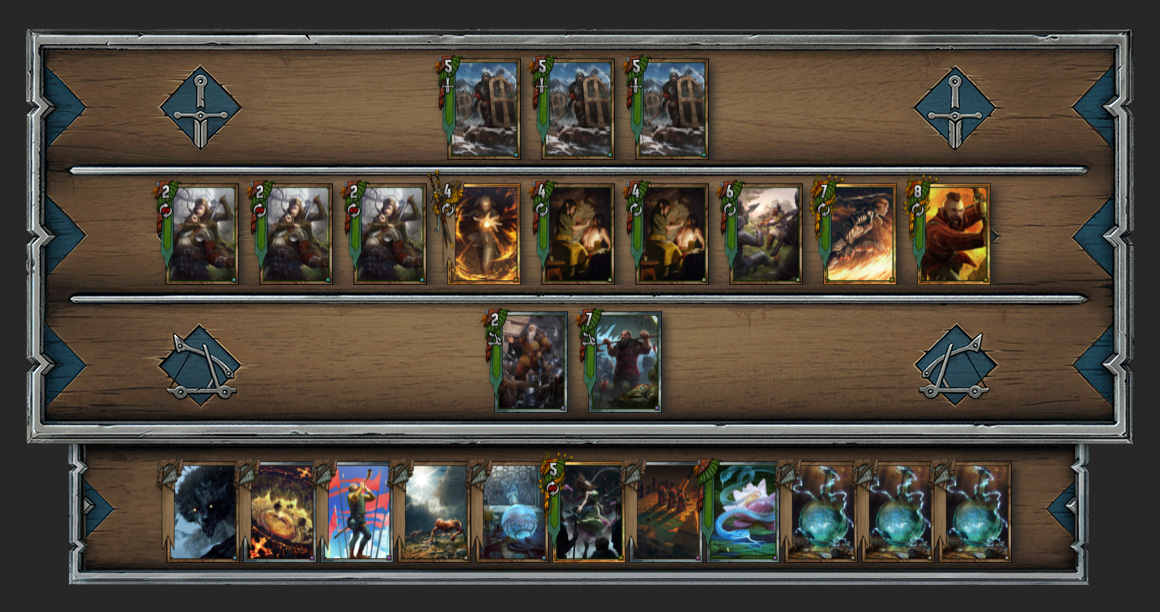
Best Scoia’tael deck: Swim’s Ithlinne Dwarves
The best thing about this deck, other than the fact it’ll win you plenty of games, is that much of its power comes from bronze cards you probably already have. The silvers and golds are luxuries, really—for the most part, the deck’s built around Mahakam Defenders and things to buff them. They gain resilience when deployed so will carry over into the next round unless you opponent locks or destroys them. Play these cards first, then, and afterwards use Elven Mercenaries to (hopefully) draw Thunderbolt Potion and Immune Boost to use on the Mahakam Defenders.
There are so many other ways to boost them. Seriously, almost every card in the deck has a boost ability. In a neat reversal, Yarpen Zigrin also gains resilience when deployed, and receives a boost every time a Dwarven ally is played. If you want to win round one, play him first then start Dwarf-stacking.
Key combos: Mahakam Defender and… basically everything else.
Correction: an earlier version of this article listed passive abilities for each faction, which were removed when it went into open beta. Many of those passive effects have been integrated into the faction leader cards.
That's it for our beginner's guide to Gwent. Jump over to page two for a glossary of terms to help you keep on top of what each card can do for (and to) you.
Phil 'the face' Iwaniuk used to work in magazines. Now he wanders the earth, stopping passers-by to tell them about PC games he remembers from 1998 until their polite smiles turn cold. He also makes ads. Veteran hardware smasher and game botherer of PC Format, Official PlayStation Magazine, PCGamesN, Guardian, Eurogamer, IGN, VG247, and What Gramophone? He won an award once, but he doesn't like to go on about it.
You can get rid of 'the face' bit if you like.
No -Ed.


